2.
GHANA
More sawnwood export permits issued in second quarter
According to a Timber Industry Development Division
(TIDD) report, 1,755 export permits were processed,
approved and issued to exporters during the second quarter
of 2011 for the shipment of timber and wood products
through the ports of Takoradi and Tema as well as via
overland routes to neighbouring ECOWAS countries.
Compared to approval levels during the previous quarter
the second quarter results were up almost 12%.
Sawnwood continues to account for the highest number of
export permits issued at almost 60% during the quarter
under review. Plywood export approvals were the second
highest accounting for around 15% of the total permits
issued.
A total of 778 permits were approved for the exports of
sawnwood, plywood and blockboard by road to Nigeria,
Niger, Benin, Mali and Togo during the quarter under
review. The total permits issued for overland export
showed an increase of 31% when compared to the figure
achieved during the previous quarter.
Permits issued for overland export totalled 43,021cu.m (up
10.5%) and these exports generated earnings of Euro 9.30
million compared to the previous quarter.
10,000 hectares targeted for 2011 plantation programme
Reports show that in 2010 a total of 20,200 hectares was
planted with various species of trees under the National
Forest Plantation Programme. In total some 67,000
hectares have been planted since 2002.
Nana Poku Bosompim, the Assistant District Manager of
the Forest Services Division, said this at Attakrom during
a visit to the Sui River Forest Reserve by members of the
Parliamentary Select Committee on Lands and Forestry.
He said the target for 2011 is a further 10,000 hectares to
ensure the continued expansion of plantation forests in the
country.
GIPC targets US$1.5 bil. non-oil investments
The Ghana Investment Promotion Centre (GIPC) has said
its target for 2011 investments is US$1.5 billion.
Investment promotion by GIPC continues to yield positive
results as reflected in its performance for the 2nd quarter.
In the quarter, 127 new non-oil projects were registered;
an increase of 21% compared to the same quarter of 2010.
The estimated total value of the registered projects for the
quarter was just over US$600 million.
Total initial capital transfers for newly registered projects
during the quarter amounted to US$97.03 million.
The FDI component of the value of the projects in the
quarter was US$552 million, or 92% of the total.
The total number of jobs expected to be created for
Ghanaians from the projects registered in the second
quarter is around 6,700 while expatriate employment is
expected to total 735.
China, with 23 projects, topped the list of countries with
the highest number of registered projects. However, with
US$128 million in estimated value of investments, the
Netherlands topped the list in terms of value of
investment.
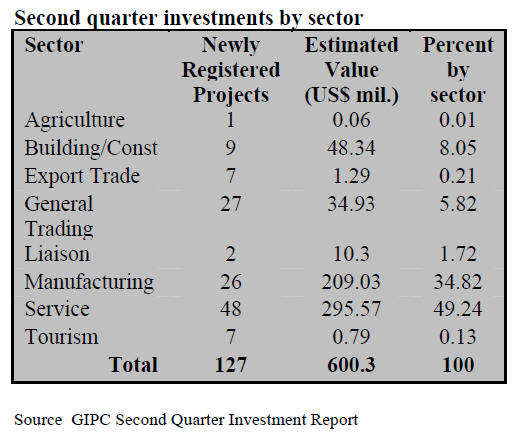
Ghana¡¯s timber manufacturers are currently seeking
business ventures with international partners in order to
upgrade manufacturing in the country, to improve
management practices and increase the range of products
offered. Opportunities for investment exist in the
following product areas:
• Finished and semi-finished furniture and
components;
• Mouldings and machined wood;
• Floor and deck blanks, strips and blocks;
• Door, window, and cabinet frames and panels;
• Dowels and tool handles;
• Peeled and sliced veneers;
• Kiln dried rough or machined lumber.
It is estimated that there are 400,000 hectares of land
currently available within Ghana¡¯s degraded forest
reserves that can be converted to commercial forest
plantations.
In addition, there exist a large number of over mature
cocoa farms and degraded areas outside reserve areas that
are also suitable for plantation development.
http://www.gipc.org.gh/pages.aspx?id=84
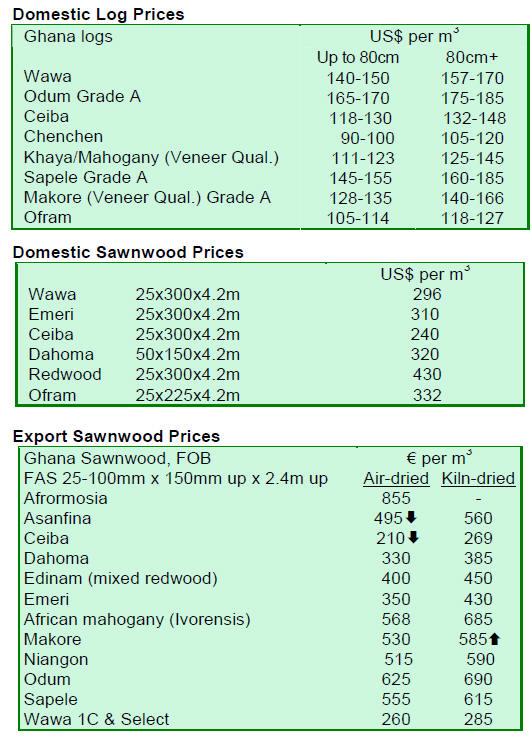
3.
MALAYSIA
Malaysia aims to maintain furniture exports at 2010
levels
Malaysia¡¯s exports of wooden furniture in 2011 are
expected be no higher than the RM6.5 billion achieved in
2010 as continued uncertainty in the global economy
weighs on the timber manufacturing and export sectors.
The appreciation of the Malaysian currency against the US
dollar and competition from new players such as Vietnam
are also affecting the confidence on the part of wooden
furniture exporters.
Cutting costs by means of more advanced machining technologies
The Ministry of Plantation Industries and Commodities
voiced the opinion that the adoption of more advanced
machining methodologies would help cut production cost
while maintaining a leading edge for the Malaysian
wooden furniture industry.
The Malaysian government has indicated its commitment
to continue providing soft loans for investors in the forest
plantation sector and will continue to vigorously support
the Malaysian Timber Certification Scheme so that it
becomes even more widely accepted internationally.
MTIB reassesses 2011 timber sector forecasts
The Malaysian Timber Industry Board is reviewing its
forecast for 2011 timber exports. Malaysia¡¯s exports of
timber and timber products amounted to RM20.52 billion
in 2010 but analysts report the likelihood is that total
exports for 2011 may be lower than those in 2010.
In contrast, demand in the domestic market remains
buoyant for the time being. Domestic consumption of
wood products is estimated to be worth around RM20
billion, out of which sawn timber accounts for just over
RM10 billion, furniture RM4 billion, plywood and other
panels RM4 billion, joinery products RM1 billion and
other timber products the remainder.
MTC to hold International timber marketing conference
The Malaysian Timber Council (MTC) will organize an
International Timber Marketing Conference in conjunction
with the fourth Malaysia International Commodities,
Conference and Showcase 2011 due to be held at the
Malaysian Agro Exposition Park Serdang on October 28th
this year.
Speakers from the USA, Europe, India, Hong Kong and
the UAE will be present to provide insights into the global
timber industry and trade. A consultation and marketing
¡®clinic¡¯ will also be held for the Malaysian industry on
October 31 with regional directors and market
correspondents and consultants in attendance. For more
information see
http://www.mtc.com.my/trade/
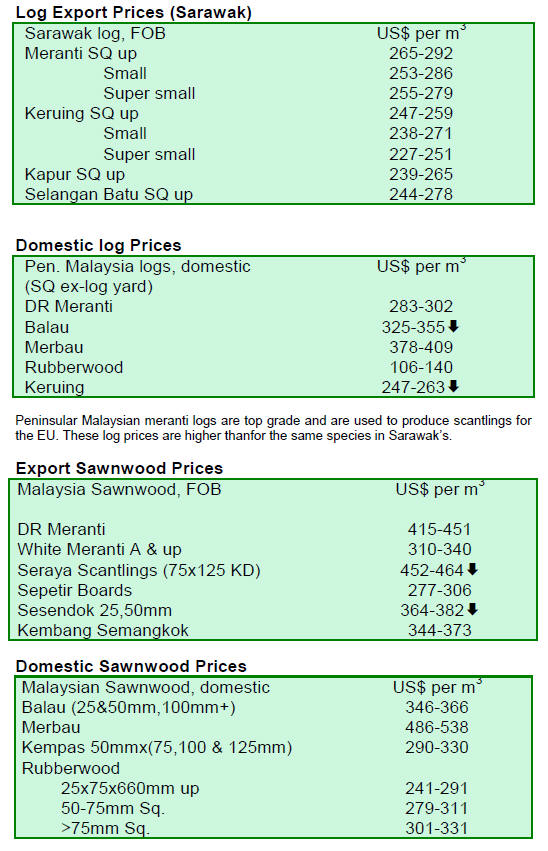
4.
INDONESIA
Counterfeit furniture deceiving
Indonesian consumers
says ASMINDO
The Indonesian domestic furniture market is worth around
USS$700 million according to the Indonesian Furniture
Entrepreneurs Association (ASMINDO). In a recent
statement ASMINDO has suggested that the domestic
market is being undermined by imports of fraudulently
labelled furniture.
To address this ASMINDO has urged the government to
tighten rules and regulations governing furniture imports
in order to offer some protection to the local furniture
industry especially from mislabelled imported furniture.
ASMINDO says it has uncovered instances of falsified
labelling and mislabelling of imported furniture after
investigating the origin of some products and the business
practices of some importers.
The government has been asked to take the necessary
steps
to make it mandatory for imported furniture be supported
by an authentic certificate of origin.
ASMINDO cited a few cases where European style
furniture with a ¡°Made in Europe¡± label was actually
manufactured in an Asian country.
The counterfeit furniture can be sold at a high price on the
domestic market, thereby deceiving the consumers.
Options mulled to detect counterfeit furniture
The head of the business unit at the Directorate of Wood
and Plantation-based Industries at the Indonesian Industry
Ministry added that it will act to put a stop to counterfeit
furniture imports.
However, the Ministry is yet to implement inspection
procedures for imported furniture. The ministry proposed
that imports of furniture be limited only to certain ports, as
is the case with the imports of food and beverages as this
will facilitate inspection.
Other options include the use of certificates of origin
to
verify the origins of products.
UK welcomes Indonesia¡¯s signing of VPA
In a press release the UK¡¯s Defra (Department for
Environment, Food and Rural Affairs) has praised the
work to tackle illegal logging with the news that Indonesia
has become the fifth country to sign a voluntary
partnership agreement (VPA) with the EU.
The press release says Indonesia is leading the way in
Asia
and has one of the biggest areas of forest in the world. Six
countries have now signed agreements with the EU, and
another four are in negotiations.
The UK Government is helping developing countries to
prevent the loss of forests as part of wider efforts to help
them both adapt to the impacts of climate change whilst
continuing their economic development.
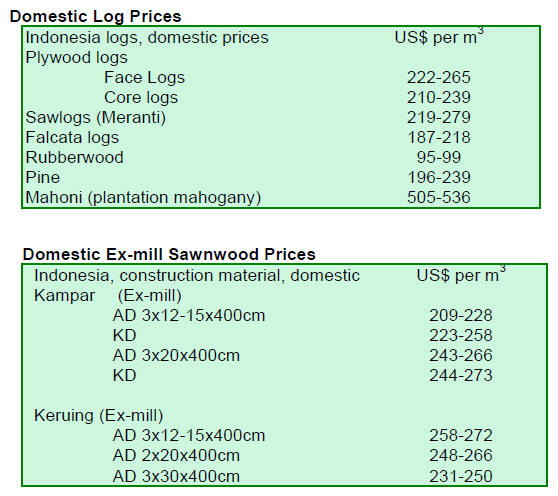
5. MYANMAR
Sale of old stock Teak logs in September
In mid September there was a further ¡®Special Open
Tender¡¯ for 920 h.tons of old stock teak logs of various
grades (SG7, SG8 and SG9) as well as some teak
thinnings held by the Myanma Timber Enterprise.
In total 904 h.tons were sold. Teak logs of SG7
grade were
sold at an average of Euro 552 per h.ton while grade SG8
logs fetched Euro 215 per h.ton. Thinning Posts, as the
thinnings are termed locally, were sold at Euro 108 per
h.ton.
Teak prices ease on news of high stocks in India
Over the past weeks analysts have noticed a weakening of
the market for teak logs. Reports suggest that stocks of
Myanmar teak logs in India are rather high and has led to a
decline in orders.
Also, the Indian Rupee has weakened from Rupees 44
in
April to almost 50 to the US dollar at present and some log
dealers reported that buyers are reluctant to open new
letters of credit fearing further currency fluctuations.
Demand for Pyinkado remains weak as in previous
months
and analysts report that demand for Kanyin (Gurjan) has
also weakened. Kanyin sales normally drop after the
Myanmar New Year in April but demand was sustained
this year as early monsoon rains hampered the transport of
logs to Yangon and this created firm demand for a longer
period than usual.
Planning for more added value production
The Yangon Times has reported that the Myanma Timber
Enterprise has decided to reduce log extraction by 50%
prior to the establishment of the ASEAN Free Trade Area
in 2015. But this has not been officially announced.
A reduction of 20% is projected to start in 2012
followed
by a further 30% reduction in 2013 to reach the target of a
50% reduction by 2015.
According to the Chairman of the Timber Merchants¡¯
Association, during the years up to 2015 the wood
industry must be reorganised for production of more
value-added products to make up for the shortfall in export
earnings.
The Yangon Times also reported that in order to
ensure
the flow of logs to domestic industry a monthly open
tender will be held by MTE. Reports suggest that Teak,
Pyinkado, and Gurjan logs will be included in the tender.
In addition, to reduce pressure on natural forests,
80,000
acres (32,375 ha) of teak plantations have been established
within the country the journal mentioned.
Myanmar Teak Log Auction Prices (natural forest
logs)
Purchases were made by competitive bidding in
September 2011.
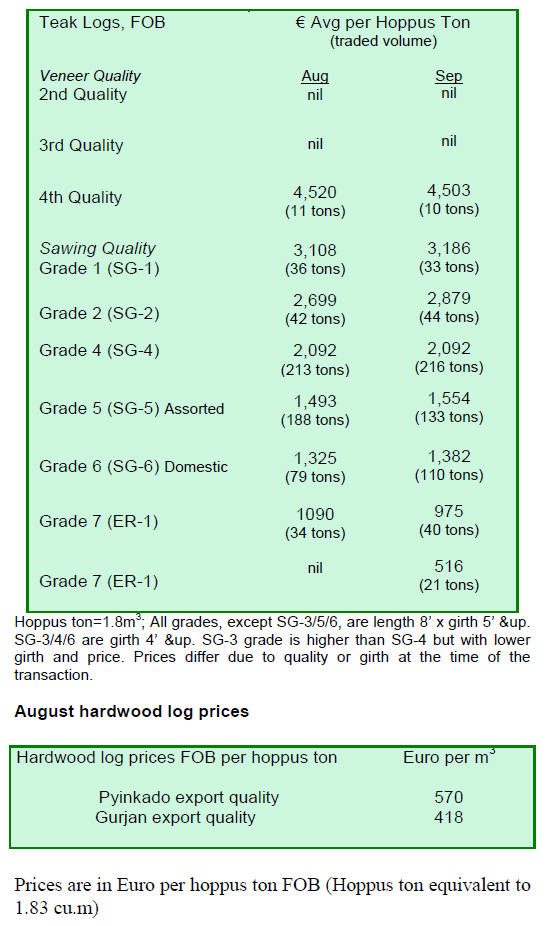
¡®Save the Ayeyarwady¡¯ campaign a challenging task
for MOECAF
The controversial Myitsone Hydroelectric Power Project
in Northern Myanmar, was in the news again recently. A
host of people from all walks of life doubt the merit of
building this dam saying the cost to the environment will
be too high and they have started a ¡®Save the Ayeyarwady¡¯
campaign.
The media in Myanmar has suggested that the
government
is re-examining this plan and that the Ministry of
Environment Conservation and Forestry will review the
environmental impact assessment.
Analysts in Myanmar say that considering the new
government¡¯s commitment to preserving the environment,
these current events may help strengthen MOECAF¡¯s role
in re-aligning the country¡¯s forest and timber trade
policies.
6. INDIA
Gandhidham emerges as a wood
manufacturing hub
Gandhidham is a city and a municipality in the Kutch
District of Gujarat State and home to India's largest port
Kandla which is around 11 km from the city. Kutch is a
growing economic and industrial hub in one of India's
fastest growing states. Its growth as a major industrial
centre on the western side of India has helped the
development of two major ports, Kandla and Mundra.
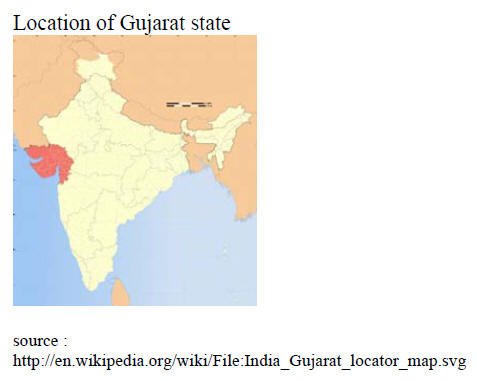
When Kutch was declared a wood industry hub it
opened
an opportunity for entrepreneurs to expand wood based
industries drawing on imported raw materials.
Today the region has one of the fastest growing wood
based industries. There are around 500 sawmills, some 70
plywood and veneer mills, 2 fibreboard plants and one
paper laminate plant in the area.
Timber imports into the area in fiscal 2010-11
reached 3.7
million cubic metres, of which just 1.23 million cubic
metres was of coniferous species. Analysts point out that
almost half the timber imports by Indian companies pass
through these facilities.
Growth of particleboard industry limited by raw
material supply
The growth in demand for particleboard in the country has
been around 30% annually in recent years making it one of
the fastest growing panel products in the market.
The commissioning of 5 to 6 new plants every year is
keeping up this momentum. Analysts say that the only
thing holding back further expansion of the particleboard
industry is the lack of raw materials.
The shortfall in domestic supplies is being made up
by
imports but local efforts to raise plantations of eucalyptus
and poplar are being made by various State Forest
Departments and by private investors. However, the
demand for raw materials is outstripping the supply.
Further interest rate increases anticipated
The Bank of India has indicated that it will continue its
aggressive monetary policy in support of the government¡¯s
continued push for growth. The Bank has been trying to
address high inflation for the past 2 years by reining in
demand through interest rate increases but many say this
has had the effect of seriously slowing economic growth.
The Bank has indicated that it will only consider
lowering
interest rates when the economy is showing signs of
cooling. On September 17, the Bank announced its twelfth
interest rate increase in eighteen months and it is expected
to raise rates again in October.
Raising plantations of endangered species
While industrial plantations are the priority for industry
analysts are calling for more attention to be given to
raising plantations of Sandalwood and Red Sanders as the
demand for these two timbers is unabated.
Newspaper reports indicate that illegal trade in
these two
precious woods continues. If new plantations are not
established, a day will come when they may become
extinct says an analyst.
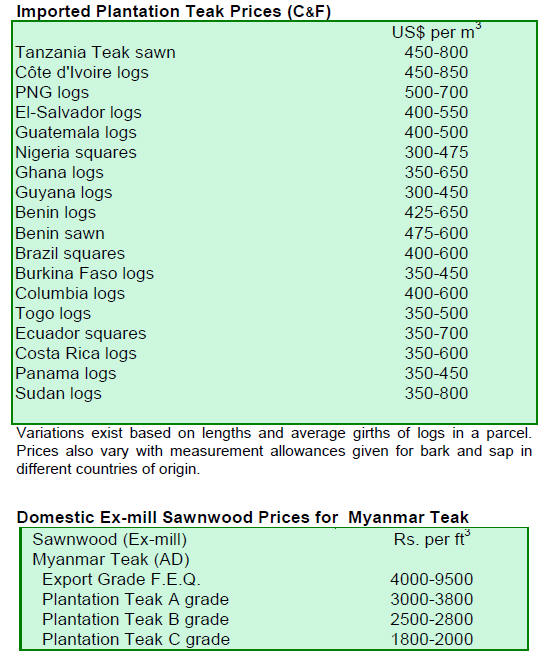
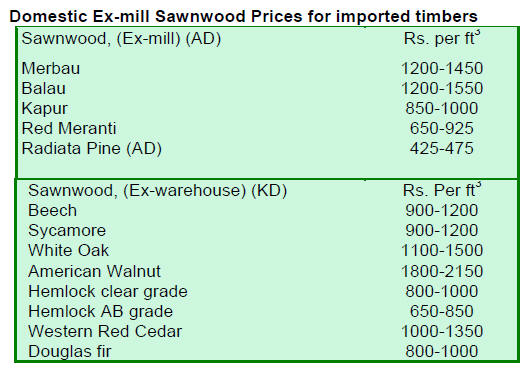
7. BRAZIL
August data shows broad based
decline in exports
In August 2011, the total value of wood product exports
(except pulp and paper) fell 2.7% compared to values in
August 2010, from US$217.4 million to US$211.5
million.
Pine sawnwood exports increased 0.7% in value in
August
2011 compared to the same month in 2010, from US$14.3
million to US$14.4 million. In terms of volume, exports
increased 6.1%, from 61,800 cu.m to 65,600 cu.m year on
year.
Exports of tropical sawnwood fell both in volume
and in
value, from 42,300 cu.m in August 2010 to 35,600 cu.m in
August 2011 and from US$19.9 million to US$18.7
million, respectively, over the same period.
This performance represents an overall 6.0% decline
in
value and 16% decline in export volumes.
Pine plywood exports dropped 23% in value in August
2011 compared to levels in August 2010, from US$32.2
million to US$24.7 million. The decline in volume
amounted to 29% over the same period, from 87,800 cu.m
to 62,600 cu.m.
Exports of tropical plywood also dropped going from
9,800 cu.m in August 2010 to 7,300 cu.m in August 2011,
representing a 25.5% decline. In terms of value, a 17% fall
was recorded, from US$5.4 million to US$4.5 million.
Exports of wooden furniture also suffered as the
value of
exports fell from US$48.1 million in August 2010 to
US$45 million in August 2011, a 6.4% decrease.
Hardwood product exports boosted by strong
performance of mills in northern Mato Grosso
Exports of wood products from mills in Alta Floresta
earned some US$22.4 million between January and
August this year according to the Ministry of
Development, Industry and Foreign Trade (MDIC). This
represents a staggering doubling of trade over the same
period last year, when exports totaled US$11.3 million.
Exports of non-coniferous wood products lead the
way at
US$11.2 million (50.3%). The United States was the main
importers of wood products from Alta Floresta, accounting
for around 37% of the year¡¯s total exports. Hong Kong
followed with 21% of the total exports. Other export
destinations included Egypt (12%), Iraq (6%) and Spain
(4%) as well as about 19 other destinations.
Plans to raise competitiveness of furniture
manufacturers in Santa Catarina
In September this year an agreement to improve the
manufacturing and trade in wooden furniture was signed
by the Wood and Furniture Producers Association of
Western Santa Catarina (Amoesc) and the Furniture and
Woodworking Industry Union of Uruguay Valley
(Simovale), and the Industry Federation of State of Santa
Catarina (Fiesc).
The purpose of this agreement is to raise the
competitiveness of participating companies, provide
support and encouragement to furniture exporters in
Western Santa Catarina and expand international
marketing activities.
A preliminary assessment made of the furniture
companies
in the Western Wood Products cluster reveals that most
are not oriented towards export markets and have little
experience in managing export marketing.
The agreement is part of an ¡®Exporting Industrial
Extension¡¯ (PEIEX) project created by the Ministry of
Development, Industry and Foreign Trade and Apex
Brazil.
The agreement will expand industry access to
support
services available from government institutions and the
private sector, provide means for technical and
management improvements and technological change.
Approximately 140 major companies of Western of Santa
Catarina are involved.
Timber prices in domestic market continue upward
trend
Prices of wood products in the domestic market in BRL
increased on average by almost 2% over the past month
but when compared in terms of US dollars the increase
was much larger being on average 3.5%.
Demand for sustainable timber could outstrip
supply
in Para says IMAZON
In a study prepared by IMAZON, (Amazon Institute of
People and the Environment), a non-profit research
institution, an assessment of the availability of forest areas
for forest management was made considering current and
future demand for timber by the wood processing industry
in Para State.
Production and consumption of wood products in Para
State is the highest in Brazil and the state currently
produces around 6.5 mil. cu.m of wood products from the
natural forest.
To ensure sustainable production it has been
estimated
that, at the current rate of harvesting, the timber sector in
Para needs approximately 100 square km of forests
assuming a cutting cycle of 30 years.
The IMAZON study suggests that the forest area
available
is insufficient to support sustainable harvesting to meet
projected increase in demand for raw material and that
some 210,000 sq. km will be required.
The report recommends policies for more effective
and
transparent preparation, approval and implementation of
forest management plans in the State with emphasis on
sustainable forest concession management planning.
Amazonas considers law on payments for
environmental services
The Northern Amazonian state of Amazonas could be the
third state in Brazil to enact laws defining payments for
environmental services aimed at encouraging the
protection of natural resources. Currently, only Acre and
Esp¨ªrito Santo have approved state laws and have actually
implemented payments for environmental services.
A commission formed by representatives from the
Forum
on Climate Change and other institutions have prepared a
draft law which is currently under discussion in
Amazonas. This is a significant issue in the State and the
broad based discussions planned will involve civil society
and the mainly forest and rural communities across the
state.
Despite ¡®hot¡¯ economy interest rates cut by half
a percent
The National Consumer Price Index (IPCA) was 0.37% in
August, after rising by 0.16% in July, according to the
Brazilian Institute of Geography and Statistics (IBGE).
The cumulative rate over the last 12 months up to August
2011 is 7.23%, the highest since June 2005 and well above
the 6.5% target set by the government.
The average exchange rate in August was BRL
1.60/US$
compared to BRL 1.76 in the same month of last year. The
appreciation of the Brazilian currency against the US
dollar continues to be of concern to exporters.
The Monetary Policy Committee (Copom) reduced the
prime interest rate (Selic) from 12.50% to 12.00% at its
meeting in the end of August. The next Copom meeting is
scheduled for mid-October.
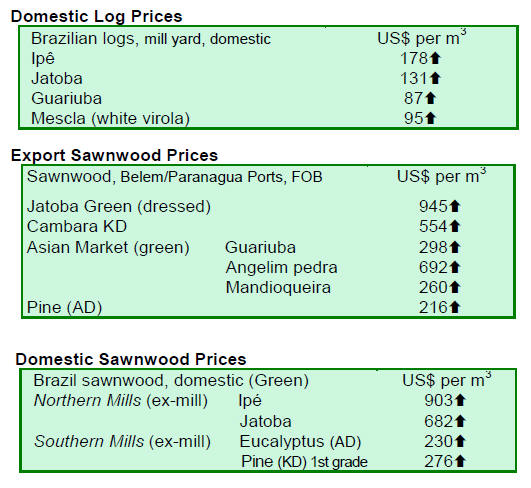
8. PERU
Growth forecasts revised
downward
Peru¡¯s Central Bank has lowered its forecast for the
country¡¯s economic growth for this year and in 2012
because of uncertainty in the economies of the United
States and Europe.
Peru¡¯s GDP is forecast to grow by 6.3% this year,
down
from a previously expected 6.5%. The Central Bank has
indicated that they expect the economy to slow in the
second half of the year to 5% and that in 2012 a growth of
only between 5-6% will be achieved.
Amazonian Ucayali Wood Technology Fair
Promotion of the Amazonian Ucayali Wood Technology ¨C
FAMATEC fair has started.
The objective of the fair, say organizers, is to
reduce the
negative impacts of the current economic crisis on the
forestry sector by developing the flow of wood products
and by diversifying markets.
According to organizers, this event is aimed at
forest
concession holders, exporters, traders, manufacturers and
all private, state and nongovernmental bodies in the
forestry and timber sectors.
Ministry of Development and Social Inclusion
established
Peru¡¯s Congress has approved the creation of a new
Ministry of Development and Social Inclusion.
This ministry will be responsible for implementing
the
government¡¯s main social programmes to improve social
inclusion for marginalized sectors of Peru that are yet to
feel the benefits of the country¡¯s economic growth.
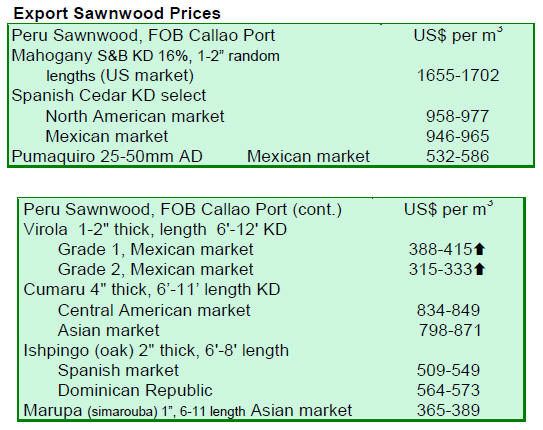
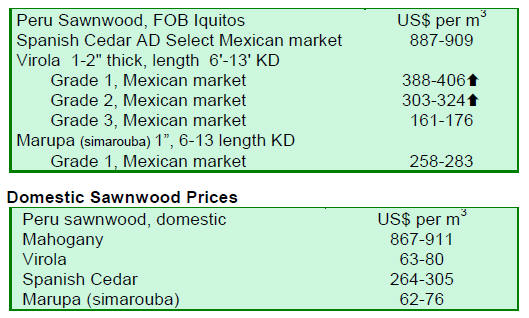
9.
GUYANA
Activity in the market
suggests a slowing of demand
During the period under review there was a reduction in
Greenheart log exports compared to levels recorded
recently. Only standard and fair sawmill quality logs were
exported.
At the same time Pupleheart log export prices
dipped for
standard and small sawmill qualities, whilst Purpleheart
fair sawmill quality log price held onto gains made
recently. In contrast, export shipments of Mora logs were
up and prices were favourable for all sawmill qualities.
Lack of direction in market for Guyana¡¯s
sawnwood
The trade in sawnwood for this fortnight showed no
particular direction. Undressed Greenheart (Select) prices
dropped at the top end of the range from US$827 to
US$615 per cubic metre. Undressed Purpleheart
sawnwood prices also declined at the top of its range from
US$1,548 to US$1,050 per cubic metre. Undressed Mora
prices remained unchanged.
Dressed Greenheart prices remained firm compared to
levels in the recent past while dressed Purpleheart prices
slid from US$1,200 to US$1,060 per cubic metre.
Plywood exports to neighbouring countries resume
Plywood exports to markets in the Caribbean and in
neighbouring countries resumed in September and prices
were reported as favourable moving to US$588 per cubic
metre.
The contribution of value added product exports for
this
period were encouraging making a noteworthy
contribution towards the total export earnings. The
Caribbean was the main destination for exports from
Guyana.
Countrywide survey to assist sawmillers and
timber producers
Following recent meetings of stakeholders on the
unavailability of sawnwood in the local market and due to
the need to encourage more utilization of Lesser Used
Species of timber, the Forest Products Development and
Marketing Council of Guyana (FPDMC) is undertaking a
country wide survey aimed at assisting sawmillers and
timber producers in the forest industry.
The main objective of this survey is to determine
the
issues affecting stakeholders and what can be done to
increase performance in their business operations.
This survey will also help identify whether Guyana
is
actually widening its species utilisation and if sawmillers
are supplying what is demanded by consumers.
LUS promotion underway in Guyana
The FPDMC is currently engaged in creating awareness of
the lesser used species locally by way of promotional
activities which include newspapers and television
advertisements.
This promotion is aimed at increasing the awareness
of
contractors, architects and home-owners of the lesser used
species timber in Guyana and helping to alleviate the
pressure on the popular commercialised species such as
Greenheart and Purpleheart.
The FPDMC, Guyana Forestry Commission (GFC) and
the Forest Producers Association (FPA) are working with
the forest stakeholders to increase the awareness of the
lesser used species selection to lessen dependency on the
popular species of timber.
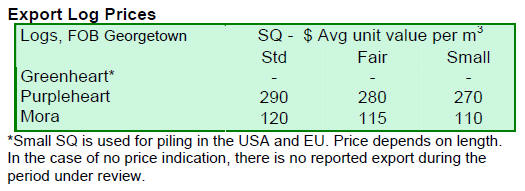
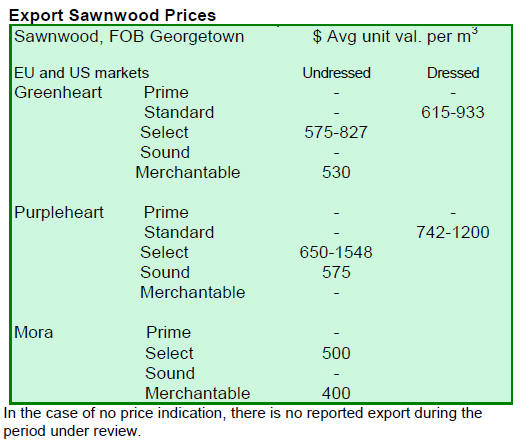
Related News: